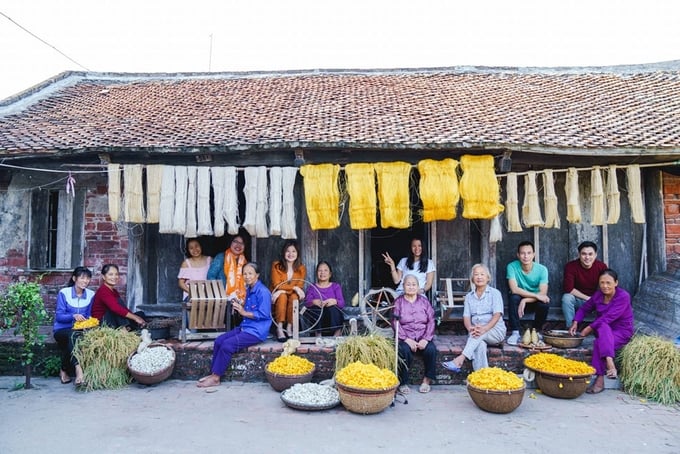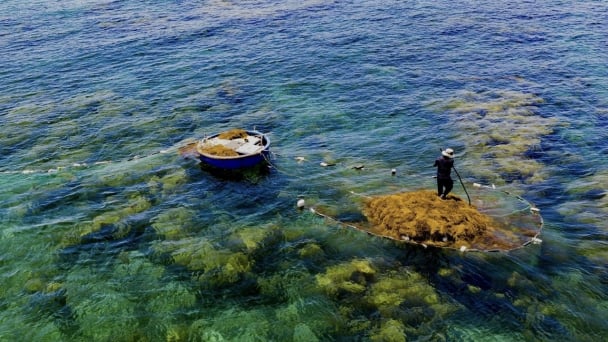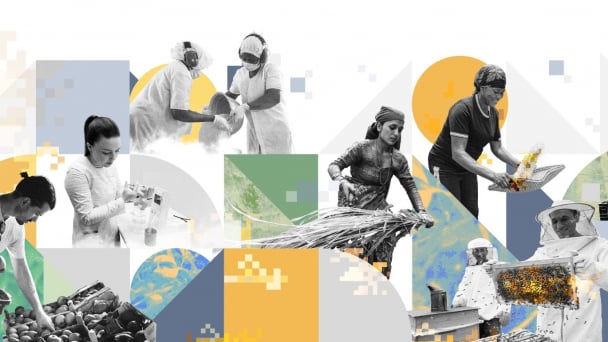June 21, 2025 | 01:26 GMT +7
June 21, 2025 | 01:26 GMT +7
Hotline: 0913.378.918
June 21, 2025 | 01:26 GMT +7
Hotline: 0913.378.918

The workshop was jointly organized by the Vietnam Agricultural Extension, the Department of Economic Cooperation and Rural Development, and the Hanoi Department of Agriculture and Rural Development. Photo: Bao Thang.
Mr. Nguyen Doan Hung, Head of the Horticulture and Forestry Extension Department, National Agricultural Extension Center (NAEC), said the country has nearly 40,000 farming households growing mulberry trees and raising silkworms. The mulberry planting area in 2022 will be about 13,200 hectares, cocoon output will reach more than 16,800 tons/year, and silk output will get about 2,000 tons yearly.
Vietnam currently ranks third in the world in silk output, behind China and India, with export value in 2022 reaching US$ 70 million annually. Most of Vietnam's raw silk is exported to India, accounting for more than 90%.
Commenting on the sericulture, Mr. Hung raised seven issues. In particular, it is emphasized that mulberry growing and silkworm raising are carried out spontaneously on a small and fragmented production scale. "There is no master plan and long-term development program to form raw material areas associated with production organization and product consumption links. Many stages of production rely on manual work," he said.
Another problem pointed out by the representative of the NAEC is that the connection between cocoon producers and buyers is not tight and lacks sustainability. Therefore, silk farming mainly produces cocoons and processes raw silk to export raw materials.
To clarify this issue, the Department of Cooperatives and Rural Development (DCRD) said that Lam Dong is the capital of Vietnam's silk production, with a growing area of 8,500 hectares. Together with the two provinces of Dak Lak and Dak Nong, the three Central Highlands provinces account for nearly 75% of the total strawberry growing area in the country. Recently, some Northwest regions such as Yen Bai and Lao Cai have focused on developing mulberry growing and raising silkworms. However, only a few localities nationwide have separate development policies for the industry.
To solve this problem, the DCRD proposes that provinces with raw material areas for silk production focus on building cooperative models and cooperative groups with silk processing and consuming enterprises.

People harvest silkworm cocoons on the outskirts of Hanoi. Photo: TL.
"It is necessary to guide silk growing households nationwide to participate in the linkage model, promote safe production processes according to VietGAP and GlobalGAP, ensure traceability, grant production unit codes, and strengthen exporting deeply processed products. From there, forming an ecosystem for the mulberry industry, helping to develop brands both domestically and internationally," this person shared.
Dr. Le Hong Van, Director of the Vietnam Sericulture Research Centre (VIETSERI), said that mulberry is the only vital food source for silkworms, determining the quality of the cocoon. They have researched the GQ2 variety, commonly grown in the North and Central regions, with an average yield of over 35 tons of leaves per hectare. In intensive farming conditions, productivity can reach 40 - 45 tons per hectare.
In the Central Highlands, two strawberry varieties, S7-CB and VA-201, are commonly grown. The VA-201 variety is a hybrid of the VA-186 and the Bau Den variety (local strawberry of Lam Dong), with branching solid characteristics and a 30 tons per hectare yield.
"In recent times, the sericulture has developed rapidly; the mulberry area has nearly doubled, but the supply of mulberry varieties still meets the demand. New domestically selected mulberry varieties have shown their superiority, contributing to limiting and preventing the use of varieties of unknown origin", commented the VIETSERI leader.
There are two main types of silkworms: mulberry silkworms and cassava leaf silkworms. However, production facilities can only partially meet the demand for multi-system varieties of golden cocoons (mulberry silkworm variety) and cassava silkworm varieties. More than 90% of the need for dual-system silkworm breeds (breeds that produce good silk quality but are difficult to raise) are still imported.
In addition to the breed issue for the mulberry industry, Mrs. Luong Thanh Hanh, Director of Nam Cao Weaving Cooperative, Thai Binh province, informed that silk production villages could diversify through contact with international customer revenues. Some of her suggestions include letting tourists experience silk weaving, building a cultural and tourism space associated with craft villages, developing many silk products, and creating enough segments for the customer base.

Traditional silk weaving artist Phan Thi Thuan, Phung Xa commune, My Duc district, Hanoi. Photo: TL.
At the workshop, Dr. Le Quang Tu, Chairman of the Vietnam Sericulture Association (VISERIA), proposed that the Ministry of Agriculture and Rural Development (MARD) consider directing an industry development strategy. According to him, only when there is a complete, systematic strategy can synchronous solutions be implemented, helping farmers and businesses overcome challenges in varieties, raw material areas, markets, and innovation.
"If we want to have a sufficient source of raw cocoons for production, we need to invest in farmers intensively cultivating mulberry gardens and invest in raising silkworms better to create the best source of cocoons to meet the needs of the silk production," Mr. Tu pondered.
In the Northern provinces, Yen Bai is among the localities that pay attention, invest, and have specific orientations for developing sericulture. Mr. Nguyen Duc Dien, Deputy Director of the Yen Bai Department of Agriculture and Rural Development, said that the province issued Resolution No. 40/2018/NQ-HDND dated December 8, 2018, for people to develop mulberry growing and silkworm rearing. As a result, the area planted more than 480 hectares of new mulberries, ten new concentrated silkworm-rearing houses, and two large silkworm-rearing houses.
From 2021 to September 2023, the People's Committee of Yen Bai province has approved funding to support nine projects to develop mulberry growing and silkworm farming production linked along the value chain with a scale of more than 570 hectares. Total support funding from the approved provincial budget is VND 5.7 billion.
"Yen Bai wishes to introduce many international and domestic organizations, businesses, silk processing and production companies to participate in the province's mulberry production and development chain to support the construction, promoting mulberries to domestic and international markets," Mr. Dien emphasized.

People in the village in Nam Cao commune, Kien Xuong district, Thai Binh are excited when the traditional craft develops. Photo: TL.
Summing up the workshop, Mr. Le Duc Thinh, Director of the DCRD, said that the MARD is implementing a pilot project to build standard agricultural and forestry product material areas for domestic consumption and exports in 2022 - 2025. Sericulture is also being studied because of its rich tradition, history, and export potential.
Through the opinions of several artisans, including Ms. Phan Thi Thuan in Phung Xa commune, My Duc district, Hanoi city, Mr. Thinh proposed that Hanoi consider building a raw material area to serve mulberry production and, at the same time, create a fund land for craft villages and businesses with conditions for development because Hanoi is considered a land of technology and has two famous weaving villages: Phung Xa and Van Phuc.
Mr. Thinh also pledged to advise and consult with the MARD leaders on creating pure silkworm varieties before assigning appropriate breeding research centers, moving forward to be proactive in breed sources. In addition, planning separate strawberry growing areas, not intercropping with other crops, and planning to train and develop high-quality human resources in silk farming.
"The sericulture value chain requires a comprehensive incentive policy. It is not just diversity of types, designs, promotion, image promotion, or silkworm breeding development of mulberry growing areas. Only a comprehensive program can maximize the potential of this industry," Mr. Thinh affirmed.
The workshop on Building raw material areas and commercial development of the sericulture industry is a part of the Vietnam Craft Village Conservation and Development Festival 2023, from November 9 to 12. The MARD and Hanoi People's Committee organizes the festival.
Translated by Tuan Huy
![Turning wind and rain into action: [10] Advancing accessible climate services for farmers](https://t.ex-cdn.com/nongnghiepmoitruong.vn/608w/files/linhnhp/2025/06/20/1911-z6704423696987_15fd32ffc26d590d204d520c9dac6786-nongnghiep-161854.jpg)
(VAN) Not only does it help farmers 'avoid droughts and rains,' the development of agricultural climate services also enhances their ability to proactively adapt to a rapidly changing climate.

(VAN) With international assistance, the harvesting of sargassum seaweed in Quang Ngai has become increasingly regulated, thereby safeguarding marine life and ensuring the stability of coastal communities' livelihoods.

(VAN) On June 19, the United Kingdom officially became a Development Partner of the Mekong River Commission.

(VAN) Biodiversity is being threatened by traditional remedies made from wildlife. Traditional medicine and humans must change to live in harmony with nature.

(VAN) Agrifood investment and finance solutions for people and the planet.

(VAN) Microplastic contamination has become pervasive in seafood, posing unprecedented challenges for food safety and marine ecosystems.

(VAN) Proactively using vaccines, combined with transport control and enhanced surveillance, is the only viable path toward biosecure and sustainable livestock production in Vietnam.